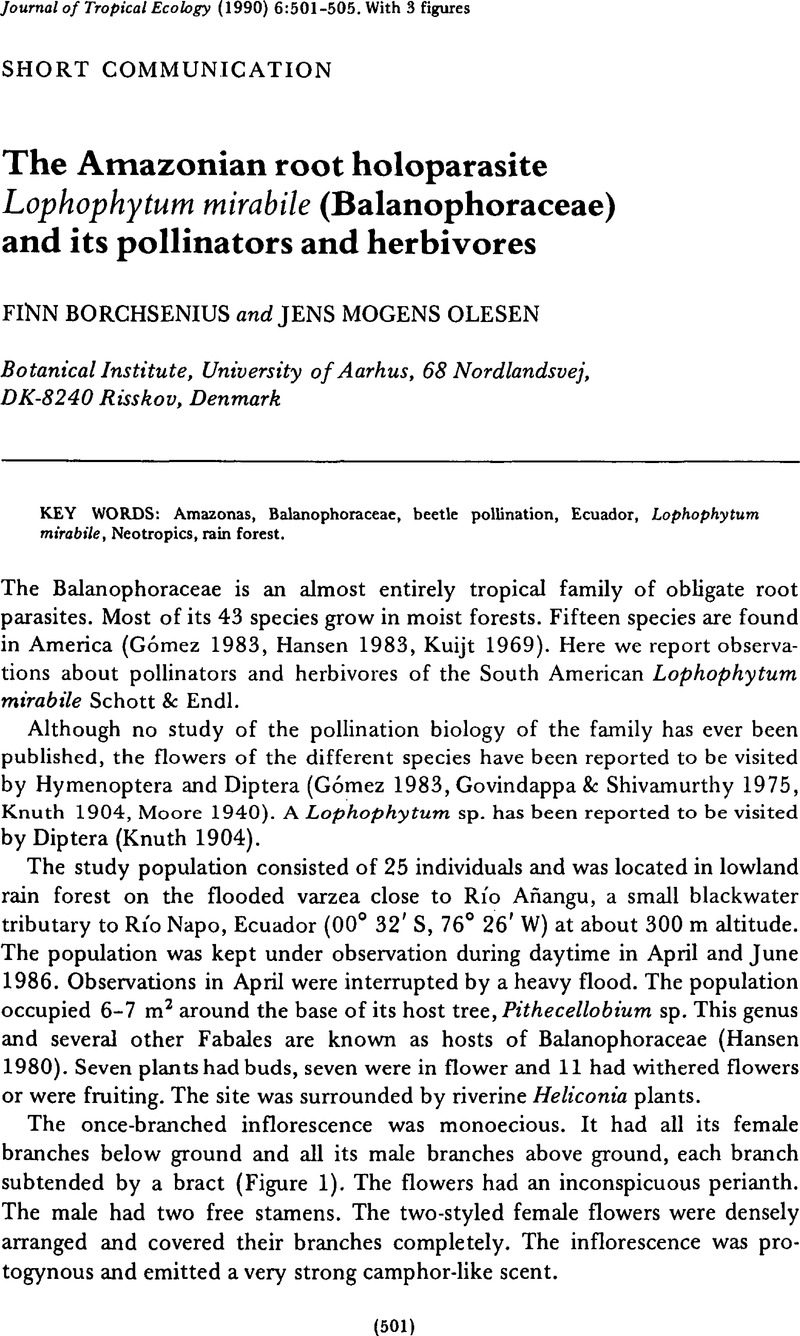Crossref Citations
This article has been cited by the following publications. This list is generated based on data provided by Crossref.
Gottsberger, Gerhard
1993.
Progress in Botany / Fortschritte der Botanik.
p.
461.
Garc�a-Franco, Jos� G.
Souza, Valeria
Eguiarte, Luis E.
and
Rico-Gray, Victor
1998.
Genetic variation, genetic structure and effective population size in the tropical holoparasitic endophyteBdallophyton bambusarum (Rafflesiaceae).
Plant Systematics and Evolution,
Vol. 210,
Issue. 3-4,
p.
271.
Kawakita, Atsushi
and
Kato, Makoto
2002.
Floral biology and unique pollination system of root holoparasites, Balanophora kuroiwai and B. tobiracola (Balanophoraceae).
American Journal of Botany,
Vol. 89,
Issue. 7,
p.
1164.
CONRAN, JOHN G.
and
BRADBURY, JOHN H.
2007.
Aspidistras, amphipods and Oz: Niche opportunism between strangers in a strange land.
Plant Species Biology,
Vol. 22,
Issue. 1,
p.
41.
GOTO, RYUTARO
YAMAKOSHI, GEN
and
MATSUZAWA, TETSURO
2012.
A novel brood‐site pollination mutualism?: the root holoparasite Thonningia sanguinea (Balanophoraceae) and an inflorescence‐feeding fly in the tropical rainforests of West Africa.
Plant Species Biology,
Vol. 27,
Issue. 2,
p.
164.
Bellot, Sidonie
and
Renner, Susanne S.
2013.
Pollination and mating systems of Apodanthaceae and the distribution of reproductive traits in parasitic angiosperms.
American Journal of Botany,
Vol. 100,
Issue. 6,
p.
1083.
Suetsugu, Kenji
and
Aoyama, Toshiyuki
2014.
Apis ceranaVisiting Flowers of the Holoparasitic PlantBalanophora fungosassp.Indica.
Entomological News,
Vol. 124,
Issue. 2,
p.
145.
Kuijt, Job
and
Hansen, Bertel
2015.
Flowering Plants. Eudicots.
p.
193.
Quintero, Elena
Genzoni, Eleonore
Mann, Nigel
Nuttman, Clive
and
Anderson, Bruce
2017.
Sunbird surprise: A test of the predictive power of the syndrome concept.
Flora,
Vol. 232,
Issue. ,
p.
22.
Santos, Jean Carlos
Nascimento, Andre Rosalvo Terra
Marzinek, Juliana
Leiner, Natália
and
Oliveira, Paulo Eugenio
2017.
Distribution, host plants and floral biology of the root holoparasite Langsdorffia hypogaea in the Brazilian savanna.
Flora,
Vol. 226,
Issue. ,
p.
65.
Sato, Hector A.
and
Gonzalez, Ana Maria
2017.
Embryogenesis, endospermogenesis and fruit development in Lophophytum (Balanophoraceae): Focus on endosperm and embryo initiation.
Flora,
Vol. 233,
Issue. ,
p.
79.
da Silva Freitas, Luana
Moreira, Leandro Marcio
de Avila, Rubem Samuel
Felestrino, Érica Barbosa
Demarco, Diego
de Sousa, Hildeberto Caldas
and
Ribeiro, Sérvio Pontes
2017.
Reproductive phenology and floral visitors of a Langsdorffia hypogaea (Balanophoraceae) population in Brazil.
Flora,
Vol. 233,
Issue. ,
p.
51.
Suetsugu, Kenji
and
Hisamatsu, Sadatomo
2020.
Potential Brood-Site Pollination Mutualism between Balanophora tobiracola Makino (Santalales: Balanophoraceae) and The Sap Beetle Epuraea ocularis Fairmaire, 1849 (Coleoptera: Nitidulidae).
The Coleopterists Bulletin,
Vol. 74,
Issue. 4,
Thorogood, Chris
and
Santos, Jean Carlos
2020.
Langsdorffia: Creatures from the deep?.
PLANTS, PEOPLE, PLANET,
Vol. 2,
Issue. 3,
p.
181.
Wang, D.
Yu, H.
Chen, G.
and
Ren, Z.‐X.
2021.
Scent chemistry and pollinators in the holoparasitic plant Cynomorium songaricum (Cynomoriaceae).
Plant Biology,
Vol. 23,
Issue. 1,
p.
111.
Rios-Carrasco, Sandra
González-Martínez, César A.
and
Vázquez-Santana, Sonia
2022.
Floral visitors of the holoparasite Bdallophytum andrieuxii Eichler: A new report of brood-site pollination and thermogenesis for Cytinaceae (Malvales).
Brazilian Journal of Botany,
Vol. 45,
Issue. 3,
p.
1047.
Baskin, Jerry M.
and
Baskin, Carol C.
2022.
Germination and Seed/Embryo Size in Holoparasitic Flowering Plants with “Dust Seeds” and an Undifferentiated Embryo.
The Botanical Review,
Vol. 88,
Issue. 1,
p.
1.
Baskin, Jerry M.
and
Baskin, Carol C.
2024.
A classification system for seed (diaspore) monomorphism and heteromorphism in angiosperms.
Seed Science Research,
p.
1.





